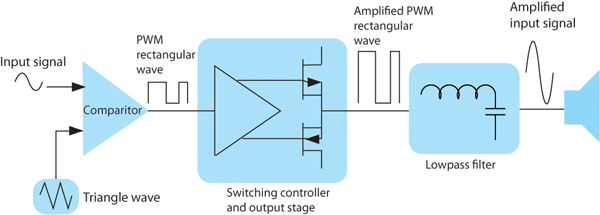
Switching, Not Linear
So far we’ve examined the switch-mode power supply inside a power amplifier. Now let’s look at how a switch-mode power amp processes the signal.
Not too many years ago, all touring power amps were linear designs, not switching. You could call a linear power amp “analog” and switching power amp “digital,” although that usage is incorrect. In an analog amp, the output devices (power transistors) operate like a variable resistance, using the input signal to modulate a strong source of current from the AC mains.
That modulated current drives loudspeakers to make sound.
Now consider a switch-mode amp. Through a process called Pulse Width Modulation or PWM, the input signal modulates the width of ultrasonic rectangular waves that are generated in the output devices.
A low-pass circuit filters out the high frequencies in those analog rectangular waves, resulting in an analog, amplified signal that goes to the loudspeakers.
In one method (Figure 2), a high-speed comparator compares a high-frequency triangle wave with the audio input.
The output is a series of pulses whose width corresponds to the input signal’s amplitude and frequency.
From the comparitor, the signal goes to a switching controller. It drives a high-power switch, which generates an amplified version of the comparator’s PWM signal.
The amplified pulses are low-passed filtered to yield rounded, high-power waves to drive the load.
PWM varies the instantaneous duty cycle of ON states and OFF states. In contrast, an A-to-D converter using PCM (Pulse Code Modulation) generates a string of 1’s and 0’s thousands of times a second.
.
Both approaches convert the “digital” signal back to analog at the output of the system.
We mentioned before that the output transistors are producing rectangular waves to be modulated by the input signal. These waves are generated by switching the power output transistors on and off at an ultrasonic fixed frequency, at the power-supply voltage of the amp.
Several pairs of transistors act as switches in push-pull mode – one transistor in a pair switches on while the other switches off, and vice versa. Class D amplifiers use that method, while Class I or BCA amplifiers operate with more sophisticated switching to generate the rectangular waves.
Class D amplifier designs have existed for about 50 years. But only in the last few years have these designs become affordable because of the enhanced power handling, efficiency and speed of modern output transistors.
As we said, the current or voltage in a transistor switch is zero when it is fully off or on. At those times, the current times voltage (power) is theoretically zero, and so is the power that is wasted as heat. In other words the efficiency of a switch-mode amp is near 100 percent.
Linear amps are a different story. Most of the time, current flows through the transistors and voltage drops across their terminals. The result is power dissipated as heat – energy that does not contribute to the signal feeding the loudspeakers.
A typical linear amp might have an efficiency of 30 percent. To prevent the amp from overheating, it uses fans and heat sinks. But a switch-mode amplifier requires less cooling and provides efficiency up to 80 or 90 percent.
No amp can be 100 percent efficient because some power is used by the input stage, so not all of the AC power from the wall outlet is used to drive a connected loudspeaker load.
Still, a switching amp can be considered “green” because it uses less energy than a conventional amp would for the same amount of output power.
Other schemes, such as making the power supply “track” the input signal, also improve efficiency.
Myth Vs. Reality
In referring to a switching power amp, the term “digital” is more of a buzzword than reality. The PWM signal in a switch-mode amp is actually an analog waveform that can be filtered. It’s digital only in the sense that it has two voltage states. It is NOT a sequence of numbers that represents the musical signal.
Many users are confused by the terminology. A “digital” amp is not an amplifier specially designed to reproduce digital sources such as CDs. It’s an amplifier that uses switching transistors in its power supply or in its audio output stages.
Products
Some power amps that include a switch-mode power supply are the QSC CX, DCA, OLX2, and Powerlight 3 series; Crown CDi, DSi, XTi, CTs, and I-Tech series, Lab.gruppen C and FP+ series, and the Yamaha P Series II. Some switch-mode (Class I) power amps are the Crown I-Tech HD Series.
Thanks to switching power supplies and switching power amps, we can roll in a rack of power without breaking our backs, and save energy too.
AES and Syn Aud Con member Bruce Bartlett is an audio engineer and audio journalist. He is the author of Practical Recording Techniques 5th Ed. and Recording Music On Location.

